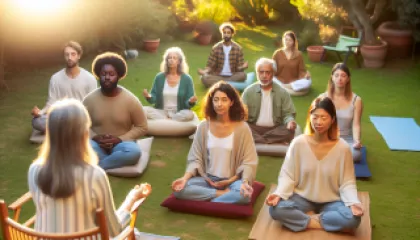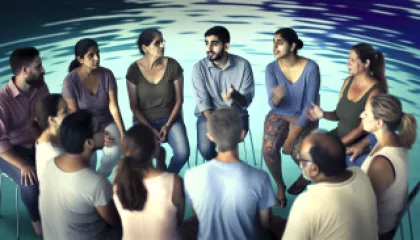Effective Meditation Techniques to Relieve Academic Stress
Academic stress is a significant issue for students worldwide. With the pressures of exams, assignments, and maintaining a balance between personal life and studies, it's no surprise that many students experience overwhelming stress. Utilizing meditation techniques to manage academic stress can be highly effective. In this tutorial, we will walk you through various meditation techniques that can alleviate academic stress, helping you become more focused and calm. Let's explore these techniques step by step.
Understanding Academic Stress
Before diving into the meditation techniques, it's essential to understand what academic stress is and its effects on the mind and body. Academic stress refers to the emotional strain and tension associated with academic demands and expectations. It can manifest in various forms such as anxiety, depression, and physical symptoms like headaches and insomnia.
Common Causes of Academic Stress
- High expectations from self and others
- Excessive workload and tight deadlines
- Lack of proper time management
- Fear of failure
- Peer pressure
Effects of Academic Stress
- Reduced concentration and memory
- Increased anxiety and irritability
- Physical symptoms such as fatigue and headaches
- Poor academic performance
- Emotional burnout
Recognizing these causes and effects is the first step towards managing academic stress effectively. Now, let's delve into the meditation techniques that can help you find relief.
Basic Breathing Meditation
One of the simplest yet most powerful meditation techniques for relieving academic stress is basic breathing meditation. This technique focuses on mindful breathing to calm the mind and body.
Step-by-Step Guide
- Find a quiet place: Choose a quiet and comfortable spot where you won't be disturbed. This could be your room, a library corner, or even a peaceful outdoor location.
- Sit comfortably: Sit in a comfortable position with your back straight. You can sit on a chair, cushion, or directly on the floor.
- Close your eyes: Gently close your eyes to minimize distractions and help focus inward.
- Focus on your breath: Pay attention to your breathing. Notice the sensation of air entering and leaving your nostrils. Keep your focus on each inhale and exhale.
- Count your breaths: If your mind starts to wander, gently bring your focus back by counting your breaths. For example, inhale (count 1), exhale (count 2), and so on up to 10, then start again.
- Practice regularly: Aim to practice this meditation for at least 10-15 minutes daily. Consistency is key to experiencing the benefits.
"Breathing in, I calm my body. Breathing out, I smile. Dwelling in the present moment, I know this is a wonderful moment." Thich Nhat Hanh
Progressive Muscle Relaxation
Progressive Muscle Relaxation (PMR) is another effective technique to reduce academic stress. It involves systematically tensing and then relaxing different muscle groups in the body, which helps release physical tension and promotes relaxation.
Step-by-Step Guide
- Get comfortable: Find a quiet place and sit or lie down in a comfortable position.
- Close your eyes: Close your eyes and take a few deep breaths to center yourself.
- Tense muscles: Start with your toes. Tense the muscles in your toes for about 5 seconds, then release them and notice the sensation of relaxation. Move up to your feet, calves, thighs, and so on, progressively tensing and relaxing each muscle group.
- Focus on the difference: Pay attention to the contrast between the tension and relaxation in each muscle group. This helps increase awareness of physical sensations and promotes deeper relaxation.
- Practice mindfulness: As you progress, maintain a mindful awareness of your body. If your mind wanders, gently bring it back to the sensations of tensing and relaxing.
- Regular practice: Incorporate PMR into your daily routine, especially before studying or bedtime, to reduce academic stress and improve sleep quality.
Guided Visualization
Guided visualization is a powerful meditation technique where you use your imagination to create calming and positive mental images. This technique can help reduce academic stress by promoting relaxation and positive thinking.
Step-by-Step Guide
- Choose a peaceful setting: Find a quiet place where you won't be disturbed. Sit or lie down comfortably.
- Close your eyes: Gently close your eyes and take a few deep breaths to relax.
- Begin visualization: Imagine a peaceful scene, such as a beach, forest, or mountain landscape. Use all your senses to make the visualization vivid. Feel the warmth of the sun, hear the sound of waves, and smell the fresh air.
- Engage your emotions: Allow yourself to feel the serenity and calmness of the scene. Let go of any stress or worries and immerse yourself in the positive feelings.
- Stay focused: If your mind starts to wander, gently bring it back to the visualization. Focus on the details and sensations of the scene.
- Practice regularly: Dedicate at least 10-20 minutes daily to guided visualization. Over time, this practice can help reduce academic stress and promote a positive mindset.
Body Scan Meditation
Body scan meditation is a mindfulness technique that involves paying attention to different parts of your body, promoting relaxation and awareness. This technique can help reduce academic stress by releasing physical tension and enhancing mental clarity.
Step-by-Step Guide
- Find a quiet place: Choose a quiet environment where you can sit or lie down comfortably without interruptions.
- Close your eyes: Close your eyes and take a few deep breaths to relax.
- Begin the scan: Start with your toes. Focus your attention on your toes and notice any sensations, tension, or discomfort. Take a few deep breaths and allow the area to relax.
- Move upwards: Gradually move your attention up through your body, focusing on each part. Spend a few moments on each area, noticing any sensations and allowing relaxation.
- Practice mindfulness: Maintain a non-judgmental awareness of your body. If your mind starts to wander, gently bring it back to the body scan.
- Complete the scan: Continue the process until you reach the top of your head. Take a few moments to enjoy the overall sensation of relaxation and awareness.
- Regular practice: Incorporate body scan meditation into your daily routine to reduce academic stress and improve overall well-being.
Mindful Walking
Mindful walking is a form of meditation that combines movement and mindfulness. This technique can help reduce academic stress by promoting physical activity and mental relaxation.
Step-by-Step Guide
- Choose a quiet path: Find a quiet and safe place to walk, such as a park, garden, or quiet street.
- Walk slowly: Begin walking slowly and deliberately. Pay attention to the sensation of your feet touching the ground and the movement of your legs.
- Focus on your breath: Coordinate your breathing with your steps. For example, take a deep breath in over three steps and exhale over the next three steps.
- Engage your senses: Notice the sights, sounds, and smells around you. Be fully present in the moment and appreciate the environment.
- Maintain mindfulness: If your mind starts to wander, gently bring your focus back to your walking and breathing. Stay present and aware.
- Practice regularly: Dedicate at least 10-30 minutes daily to mindful walking. This practice can help reduce academic stress and improve overall mental and physical health.
Loving-Kindness Meditation
Loving-kindness meditation, also known as Metta meditation, involves cultivating feelings of compassion and love towards oneself and others. This technique can help reduce academic stress by promoting positive emotions and reducing negative thoughts.
Step-by-Step Guide
- Find a quiet place: Choose a quiet and comfortable spot where you won't be disturbed.
- Sit comfortably: Sit in a comfortable position with your back straight. Close your eyes and take a few deep breaths to relax.
- Start with yourself: Begin by silently repeating phrases that express loving-kindness towards yourself, such as "May I be happy, may I be healthy, may I be safe, may I live with ease."
- Expand to others: Gradually extend these wishes to others. Start with someone you care about, then move to a neutral person, and finally to someone you may have difficulty with. Repeat phrases like "May you be happy, may you be healthy, may you be safe, may you live with ease."
- Include all beings: Ultimately, extend loving-kindness to all beings. This can include people, animals, and the planet as a whole.
- Practice regularly: Dedicate at least 10-20 minutes daily to loving-kindness meditation. This practice can help reduce academic stress and promote a sense of connection and compassion.
Mindful Eating
Mindful eating is a meditation technique that involves paying full attention to the eating experience. This technique can help reduce academic stress by promoting healthy eating habits and enhancing the enjoyment of food.
Step-by-Step Guide
- Choose a quiet setting: Find a quiet place to eat without distractions such as TV, phones, or computers.
- Prepare your meal: Prepare a meal with a variety of colors, textures, and flavors. This enhances the sensory experience of mindful eating.
- Sit down to eat: Sit at a table and take a few deep breaths to center yourself before starting your meal.
- Engage your senses: Before taking the first bite, take a moment to appreciate the appearance, aroma, and texture of the food.
- Eat slowly: Take small bites and chew thoroughly. Pay attention to the flavors and textures with each bite.
- Be present: Stay fully present during the meal. If your mind starts to wander, gently bring your focus back to the eating experience.
- Express gratitude: Take a moment to express gratitude for the food and the effort that went into preparing it. This can enhance the overall experience and promote positive emotions.
- Practice regularly: Make mindful eating a regular practice, especially during stressful times. This can help reduce academic stress and promote a healthier relationship with food.
Gratitude Meditation
Gratitude meditation involves focusing on things you are grateful for. This technique can help reduce academic stress by shifting your focus from negative thoughts to positive ones and promoting a sense of appreciation.
Step-by-Step Guide
- Find a quiet place: Choose a quiet and comfortable spot where you can sit without distractions.
- Sit comfortably: Sit in a comfortable position with your back straight. Close your eyes and take a few deep breaths to relax.
- Focus on gratitude: Think about things you are grateful for. These can be simple things like a sunny day, a kind gesture, or a delicious meal.
- Express gratitude: Silently express gratitude for each thing you think of. For example, "I am grateful for the support of my family," or "I am grateful for the opportunity to learn and grow."
- Feel the gratitude: Allow yourself to fully experience the feeling of gratitude. Notice any positive emotions or physical sensations that arise.
- Practice regularly: Dedicate at least 10-15 minutes daily to gratitude meditation. This practice can help reduce academic stress and promote a positive outlook on life.
Conclusion: Integrating Meditation into Daily Life
Integrating meditation techniques into your daily life can significantly help to reduce academic stress and improve your overall well-being. The key is consistency and finding the techniques that work best for you. Here are some tips to help you integrate these practices into your routine:
- Start small: Begin with just a few minutes of meditation each day and gradually increase the duration as you become more comfortable.
- Create a routine: Set aside specific times each day for meditation. This could be in the morning, during study breaks, or before bedtime.
- Be flexible: Adapt your meditation practice to fit your schedule and needs. If you miss a session, don't be discouraged. Simply resume your practice the next day.
- Combine techniques: Experiment with different meditation techniques and combine them to create a personalized practice that works best for you.
- Seek support: If you're finding it challenging to meditate consistently, consider seeking support from an academic stress coach or joining a meditation group.
By incorporating these meditation techniques into your daily life, you can cultivate a sense of calm, clarity, and resilience, ultimately reducing academic stress and enhancing your academic performance and overall well-being.






